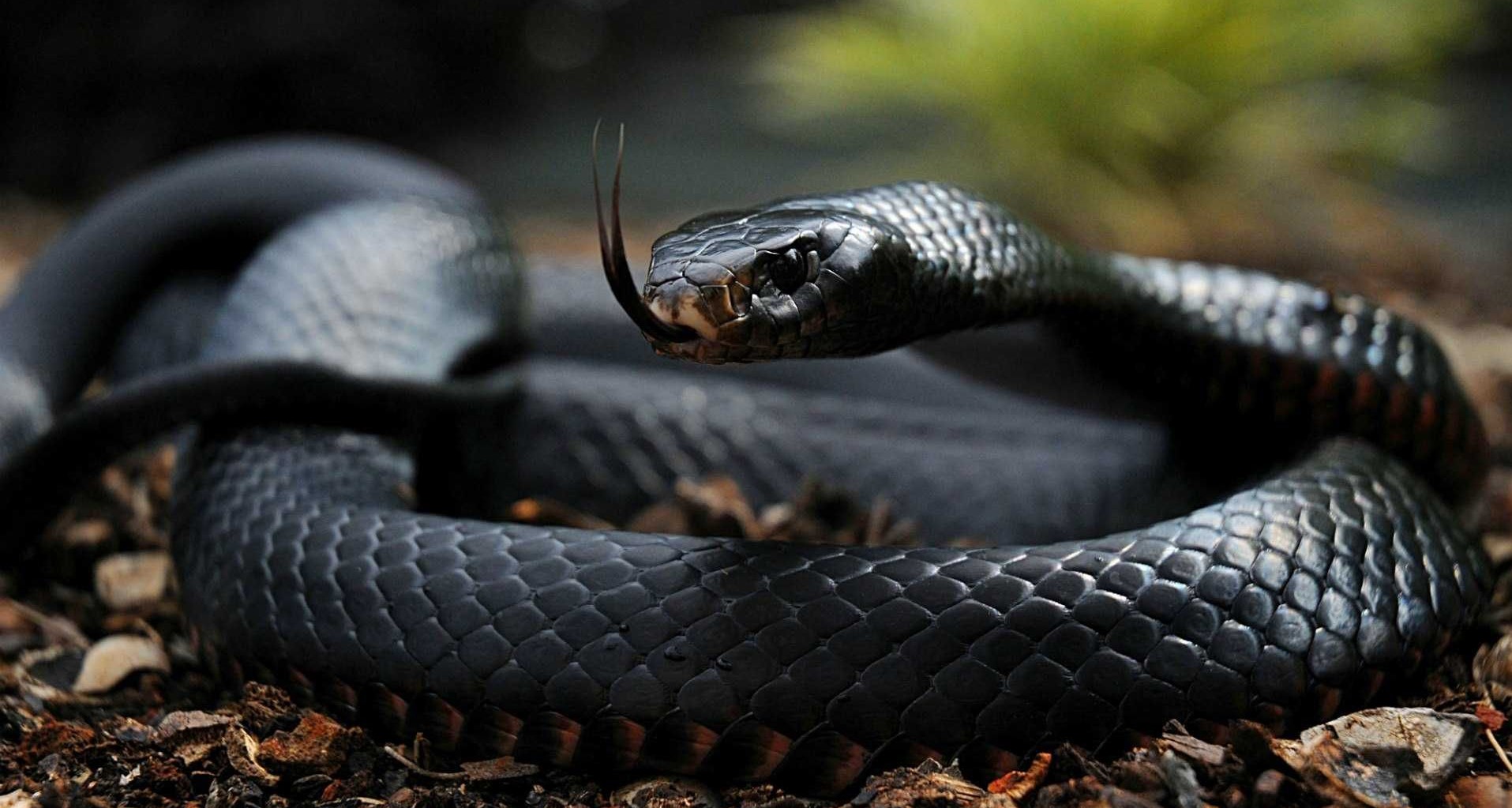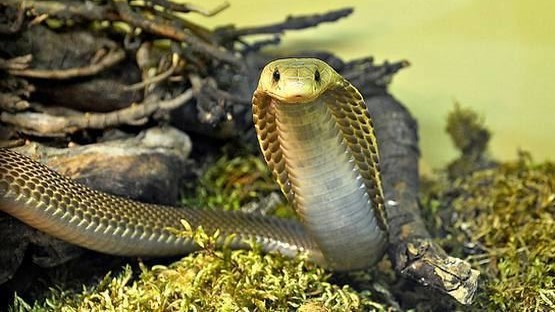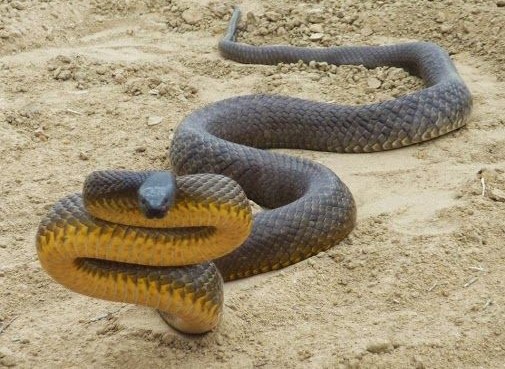Most Dangerous and Venomous Snakes in the World..
Black Mamba
The black mamba has quite a reputation. It is one of the world’s deadliest snakes. It is the fastest land snake in the world, and “the longest species of venomous snake in Africa and the second longest in the world. they are considered a top killer in a land where nearly 20,000 people die from snake bites every year, according to PBS’s Nature.
Unlike other snakes, the Black Mamba typically delivers multiple bites when it strikes. Its venom, which is composed primarily of neurotoxins, induces symptoms within a span of 10 minutes and is fatal if antivenom is not administered rapidly.
Rather than causing local swelling and necrosis (like many venomous snake bites), a Black Mamba’s venom often causes severe tingling, a metallic taste in the mouth, drooping eyelids, neurological dysfunction, blurred vision, and paralysis of the respiratory system. Extreme drowsiness, inability to speak, nausea, vomiting, and extreme sweating are also common.
Humans that are bitten by a Black Mamba will usually die within anywhere from 30 minutes to 3 hours after injection if medical treatment is not administered rapidly, but fatalities have been reported in as little as 20 minutes after injection. Unfortunately, antivenom is not widely available in many of the rural areas the Black Mamba calls home, where deaths caused by this highly venomous snake are still frequent.
The Mohave Rattlesnake feeds on rats, mice, lizards, birds, and frogs. It uses venom injected through long, hollow, retractable fangs to kill and begin digesting its prey.
The venom of the Philippine cobra is a potent postsynaptic neurotoxin which affects respiratory function and can cause neurotoxicity and respiratory paralysis, as the neurotoxins interrupt the transmission of nerve signals by binding to the neuromuscular junctions near the muscles. Research has shown its venom is purely a neurotoxin, with no apparent necrotizing components and no cardiotoxine. These snakes are capable of accurately spitting their venom at a target up to 3 metres (9.8 ft) away. The symptoms of a bite might include headache, nausea, vomiting, abdominal pain, diarrhea, dizziness, and difficulty breathing. Bites by the Philippine cobra produce prominent neurotoxicity with minimal to no local signs. A study of 39 patients envenomed by the Philippine cobra was conducted in 1988. Neurotoxicity occurred in 38 cases and was the predominant clinical feature. Complete Respiratory failure developed in 19 patients, and was often rapid in onset; in three cases, apnea occurred within just 30 minutes of the bite. There were two deaths, both in patients who were moribund upon arrival at the hospital. Three patients developed necrosis, and 14 individuals with systemic symptoms had no local swelling at all. Both cardiotoxicity and reliable nonspecific signs of envenoming were absent. Bites by the Philippine cobra produce a distinctive clinical picture characterized by severe neurotoxicity of rapid onset and minimal local tissue damage.
Although venom toxicity values can vary greatly even among specimens of the same species, the Philippine cobra is considered to possess one of the most toxic venom among all of the Naja (cobra) species based on murine LD, according to most toxinology studies. The average Sucutan LD for this species is 0.20 mg/kg (lowest LD value 0.14 mg/kg) and the average venom yield per bite is 90–100 mg. Only the Caspian Cobra (Naja oxiana) has produced a more potent venom, producing an average of 0.18 mg/kg (lowest LD value 0.1 mg/kg).
Russell's viper (Daboia russelii) is a species of venomous snake in the family viperidae,the family which includes the venomous Old World Vipers. The species is found in Asia throughout the Indian Subcontinent, much of Southeast Asia, southern China and Taiwan. The species is named after Patrick Russell (1726–1805), a Scottish herpetologist who first described many of India's snakes, and the name of the genus is from the Hindi word meaning "that lies hid", or "the lurker". In Odia and Bangali this snake is called chandra-boda and chandroborha respectively since it carries lenticular or more precisely lunar marks all over its body. In Manipuri or Meitei this snake is called Lindu and a folk story Kangleipak is associated with it. In Marathi this snake is called ghonas. Apart from being a member of the big four snakes in India, Daboia is also one of the genera responsible for causing the most snakebite incidents and deaths among all venomous snakes on account of many factors, such as their wide distribution, generally aggressive demeanor, and frequent occurrence in highly populated areas.
Chain Vipers produce a considerable amount of venom in their bites, which are highly lethal to humans in doses of 40–70 milligrams.
Common symptoms from a Chain Viper bite include excessive bleeding (particularly in the gums and urine), a rapid drop in blood pressure (and heart rate), blistering, necrosis, vomiting, facial swelling, kidney failure, and blood clotting.
For individuals who seek emergency attention, antivenom is relatively effective against the Chain Viper. However, pain from the bite often continues for approximately four weeks and is known to cause severe tissue damage. Approximately 29% of survivors also suffer from damage to their pituitary glands.
The common death adder (Acanthophis antarcticus) is a species of death adder native to Australia. It is one of the most venomous land snakes in Australia and globally. While it remains widespread (unlike related species), it is facing increased threat from the ongoing Australian cane toad invasion. Death Adders are quite short, with triangular heads and small scales adorning their bodies. They also possess large fangs, as well as a “lure” at the end of their tail that resembles a small worm. Typically, the Death Adder maintains a shade of black or grey. However, some Death Adder species can take on a reddish-yellow, brown, or greenish-grey hue.
The common death adder venom contains highly toxic neurotoxin which can cause paralysis or even death. It can deliver the fastest strike among all venomous snakes recorded in Australia. Human death can occur within six hours after the bite.Similar to other snakes in this list, the venom often causes paralysis, as well as a complete respiratory system shutdown. Although antivenoms have been developed for the Death Adders, deaths still occur from their bite as antivenom is only able to slow down the progression of symptoms to a degree.
Eastern Brown
Inland Taipan
The Inland Taipan has the most toxic venom of any land snake in the world.
Yet there has never been a single recorded human fatality from a bite of this snake!
The other 9 of the ‘Top Ten’ most poisonous snakes on earth also live here in Australia. Yet more Australians die every year from bee stings than they do from snake bite.
Visitors to Billabong Sanctuary have a rare chance for a close encounter with the Inland Taipan, as well as other potentially deadly reptiles, safely housed in large enclosures.
The Taipan’s venom contains high levels of neurotoxins. One bite from a Taipan often results in paralysis of the victim’s nervous system and clots the blood, preventing an adequate flow of blood through the blood vessels. Headache, nausea/vomiting, convulsions, paralysis, and myolysis are also common results of Taipan bites, with respiratory paralysis setting in anywhere from 2 to 6 hours after the bite.
Prior to the development of Taipan-specific antivenom in 1956, only two individuals were reported to have survived the snake’s bite. But the window of use for this antivenom is fairly small, so getting medical help immediately is critical (as with all venomous snake bites, of course!).
This is the good news. The Inland Taipan lives in the far west and southwest of Queensland, extending through the far west of New South Wales into the northeast corner of South Australia, and into the southeast of the Northern Territory.
This distribution includes the drainage systems of the Cooper and Diamantina Rivers, as well as the Bulloo, Paroo, Warrego and lower Darling.
Few people live in this remote, hot, dry country, and the Inland Taipan is rarely encountered.
To escape the blistering heat of this open country, the Inland Taipan shelters in abandoned animal burrows, deep fissures in cracked ground, rock crevices and sink holes.
Blue Krait
Binomial name: Bungarus candidus, Carolus Linnaeus, 1758
Bungarus candidus, commonly known as the Malayan krait or blue krait, is a highly venomous species of snake. The blue krait is a member of the elapid family.
The Malayan krait may attain a total length of 108 cm (about 3.5 ft), with a tail 16 cm (6.3 in) long.
Dorsally, it has a pattern of 27-34 dark-brown, black, or bluish-black crossbands on the body and tail, which are narrowed and rounded on the sides. The first crossband is continuous with the dark color of the head. The dark crossbands are separated by broad, yellowish-white interspaces, which may be spotted with black. Ventrally, it is uniformly white.
An unbanded black phenotype also occurs in some populations e.g. Bali and reportedly in West and Central Java.
The smooth dorsal scales are arranged in 15 rows, with the vertebral row much enlarged. The ventrals number 195-237; the anal plate is entire; and the single (undivided) subcaudals are 37-56 in number.
The Blue Krait’s venom is highly potent and consists of extremely powerful neurotoxins that paralyze its victim’s muscular system. The neurotoxins are made up of presynaptic and postsynaptic toxins that are known to directly attack an individual’s ability to speak or think clearly. The Blue Krait’s venom also attacks an individual’s respiratory system, causing suffocation from an inability to breathe within four hours.
Belcher's Sea Snake
The Hydrophis belcheri, also known as the faint-banded snake or, more commonly, “Belcher’s Sea Snake” is a highly venomous snake species of the elapid family. Widely considered one of the most deadliest snakes in the world due to its potent venom, one drop of the Belcher’s Sea Snake’s venom is capable of killing a human within minutes. The sea snake grows to impressive lengths by adulthood (at approximately one meter in length), and has a thin, chrome colored body with yellow and green crossbands. Possessing a small, flattened head, along with a compressed body and set of scales, the sea snake is capable of moving throughout the water at high speeds (approximately twelve miles per hour), allowing it to ambush and subdue its prey with relative ease. The sea snake lives most of its life underwater, and only occasionally surfaces for air (since they do not possess gills). They also possess a flattened tail (similar to a flipper) that they use to move quickly through the water.
The Belcher Sea Snake is named after the British explorer, Sir Edward Belcher, who first discovered the snake in the mid-1800s. It was later named by John Edward Gray in 1849.
Venom from the Belcher’s Sea Snake is so toxic, that a single bite can kill a human being in less than thirty minutes. Some studies have even indicated that the venom may be a hundred times more toxic than the deadly Inland Taipan Snake. Containing high levels of neurotoxins and myotoxins, one drop of the snake’s venom is capable of killing 1,800 people. Symptoms of the snake’s bite include extreme vomiting, nausea, migraines, excruciating abdominal pain, diarrhea, dizziness, convulsions, and paralysis. Other symptoms include hysteria, uncontrollable bleeding, as well as respiratory and kidney failure. Although antivenoms have been developed to combat the toxicity of the snake’s bite, immediate treatment is crucial for survival.
Fortunately, the Belcher’s Sea Snake is quite mild-mannered in its temperament, and only rarely bites humans. Moreover, recent studies have also indicated that the sea snake is capable of controlling its venom secretion, and releases venom only in a quarter of its bites. Because of their relatively small fangs, researchers have also discovered that it is quite difficult for the Belcher’s Sea Snake to bite humans, particularly when they are wearing diving gear or a scuba suit. Along with their small mouth, there are only a limited number of places on the human body that a sea snake can latch on to with their mouth (such as a finger or toe), as their jaws are incapable of opening very wide.










No comments